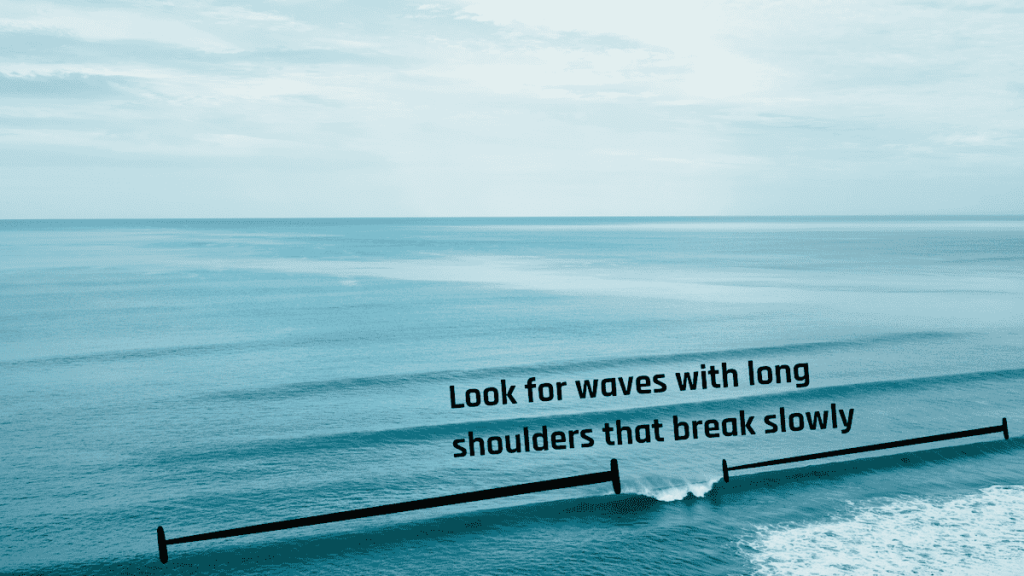Reading waves for surfing:
5 steps to improve your wave selection
Lesson 13
- Written by Emilia
- Published February 12, 2024
Post contents
Introduction
Do you struggle to understand which waves are good waves and which waves are bad waves to surf? Then this lesson is for you. Maybe when reading waves for surfing you often select waves that are too weak, spend a lot of energy trying to catch them without success, ending up tired and missing all the good waves. Or on the other hand, maybe you are too patient with your wave selection, letting the good waves go and not realising they are good waves until it’s too late.
In this lesson I will teach you five important things to consider when selecting your waves, to improve your wave selection and catch more waves when surfing.
5 steps to improve your wave selection and ride more waves
1. Inspect the conditions from land
Before selecting a location and spot to surf at you should inspect the conditions from land. Some of the steps described below can be used on land before you enter the water to inspect if the waves live up to good surfing conditions or not. Choosing a good spot in the water can massively impact the number of waves you will catch.
During a recent surf trip I was struggling to catch waves in the spot I was at. I got out of the water, spent a few minutes on land to inspect the different spots in the water, and went back in to a spot in the water that was more suitable for me (the waves were a bit smaller at the new spot I selected which made things a bit easier and less intimidating for me).
2. Look for bumps
Although you should study the waves before going into the water, the ocean is constantly changing, so you also have to learn how to adapt when in the water to make sure you are always in the best spot. While sitting in the lineup looking for waves, you need to continuously scan the ocean looking for bumps. Those bumps can give you an indication that waves might be coming and where you potentially need to paddle to reposition yourself and catch them.
- Do: Continuously scan the ocean while sitting in the lineup. Look for bumps on the water's surface, as they can indicate there are incoming waves and help you reposition yourself to catch them.
- Avoid: Assuming the ocean will stay the same. Even if you've studied the waves beforehand, the ocean is always changing. Adaptability is key, so be prepared to adjust your position based on the constantly changing conditions.

3. Identify taller waves
Picking a good wave includes considering wave height, more specifically looking for taller waves. What a taller wave looks like is a distinct, dark line on the horizon. They do stand out from more flat waves where the dark line is not as distinct. Try to identify them as early as possible during your wave selection.
- Do: Look for taller waves. They have a distinct, dark line in the horizon.
- Avoid: Flatter waves. They do not have a distinct, dark line in the horizon.

4. Identify the peak of the wave
When you’re out in the water, you might notice a dark line on the horizon from the wave. Sometimes, one part of this line is darker than the rest, especially at the tallest point called the peak. The peak is where the wave starts to break. Ideally (in a perfect world), you’d want to catch the wave right at the peak or as close to it as you can, while avoiding the parts where the wave closes.
But sometimes it’s hard to tell which part of the line is darkest, and the whole wave might just look like a solid dark line. These waves are steep and likely to close all at once (sometimes right over you…), leaving no space to ride them. They are called closeouts. It’s best to avoid closeouts and look for waves with clear peaks.
- Do: Look for waves with a clear peak. You'll see one part at the top of the wave that's darker than the rest.
- Avoid: Closeouts. They might just look like a solid black line on the horizon without any fading.

5. Identify waves with long shoulders that break slowly
Another part of wave selection includes identifying waves with long shoulders that break slowly. The shoulder of a wave refers to how much water is in it. A good shoulder is long and gently sloping, which means it will break slowly, giving you a longer ride time. You’ll notice this as a gradual change in color along the wave with a clear peak. Picture a surfer riding it. Can they realistically stay on?
Stay away from waves with short shoulders. These are steep, brief, and often fade away quickly. While they might be fast, they don’t offer much water for a ride, quickly fizzling out. You’ll use up your energy for a short ride. You can recognize a short shoulder by its steepness, brief duration, and how quickly it fades away. It lacks the gradual, gentle slope of a longer shoulder and typically doesn’t offer much water for a longer ride.
- Do: Look for waves that have long shoulders and break slowly. Long shoulders are sloping and long, and you can spot them by noticing a change in color along the horizon that fades slowly.
- Avoid: Short shoulders. You can spot them by looking for a sloping, steep line on the horizon.

Lesson quiz: test your knowledge

Time's up
I’d love to hear your thoughts on this post! Whether you have suggestions for improvement, want to share what you liked, or have any questions, feel free to leave a comment below. Your feedback helps me create better content for all aspiring surfers!